A complete audience database is probably the most valuable collection of data for any company. Segmentation is one of the basic functions of marketing automation. It allows, among others, for targeting advertising messages, enabling their customisation, and thus – increasing the effectiveness of marketing campaigns. What are the segmentation criteria and how to segment the audience using PushAd?
Sending push notifications to the selected segment
Audience segmentation is one of the elements of the STP (segmentation, targeting, positioning) marketing strategy. The activities consist in dividing the market into segments and then profiling, i.e. classifying users to a group by their characteristic features. Targeting is the process of directing the advertising message to the appropriate target group, potentially the most interested in the company’s offer. Positioning refers to shaping a positive image of a product in the eyes of potential customers. All these processes are necessary for the proper operation of marketing automation.
The appropriate method of data organisation significantly facilitates the audience management, allowing for even more effective advertising campaigns. Base segmentation in the PushAd tool aims to identify valuable contacts based on their characteristic features and behaviours. It is important that the audience database is up-to-date, consistently labelled, filled with correct data and properly segregated. The PushAd platform offers great opportunities for customer base segmentation, constituting the basis for sending personalised advertising campaigns. In the PushAd panel, there is a “Subscribers” tab. After selecting this option, the “Segments” module will appear, where the subscribers base grouped by the selected criteria will be displayed. This is the first step to creating advertising messages perfectly matching the needs and expectations of the audience.
For example, an online store selling women’s clothing and accessories may use consumer data according to their behaviour on the website or products most frequently viewed in the online store. Customised advertising messages will be sent to the created segment in accordance with the goals and assumptions of the campaign. The PushAd tool enables automatic user segmentation, based, among others, on sitemap, breadcrumbs, URL parameters, and manual segmentation, relying on custom parameters, e.g. data layer, digital data, cookies, and specific user behaviour on the website.
Sitemap-based segmentation
The first of the mentioned types of segmentation is based on a sitemap placed on the server – an XML file containing a list of all subpages of a given website, creating the content structure used by web browsers. It is the same file that we embed in Google Search Console for proper website indexation. Based on the data contained in the sitemap, PushAd automatically creates a full segmentation, building individual segments from each subpage. It is worth paying attention to the fact that this solution is extremely convenient due to the full automation – along with the update of the sitemap, we also make changes to the segmentation, which allows you to maintain the appropriate data structure without much effort. To sum up – one visited subpage equals one segment, visiting this page by users translates into an increased size of the segment.
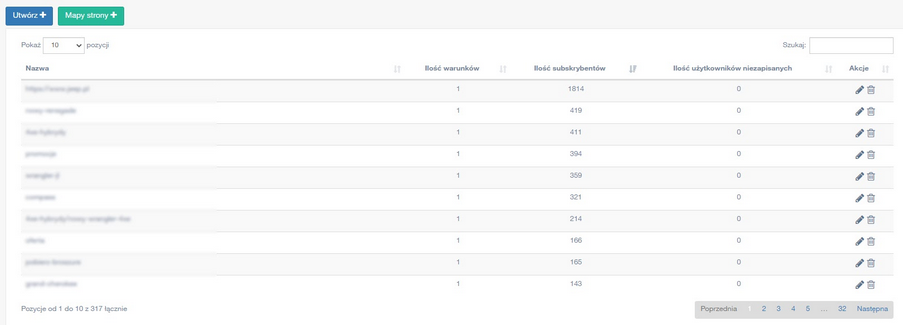
Listing of ready website segments
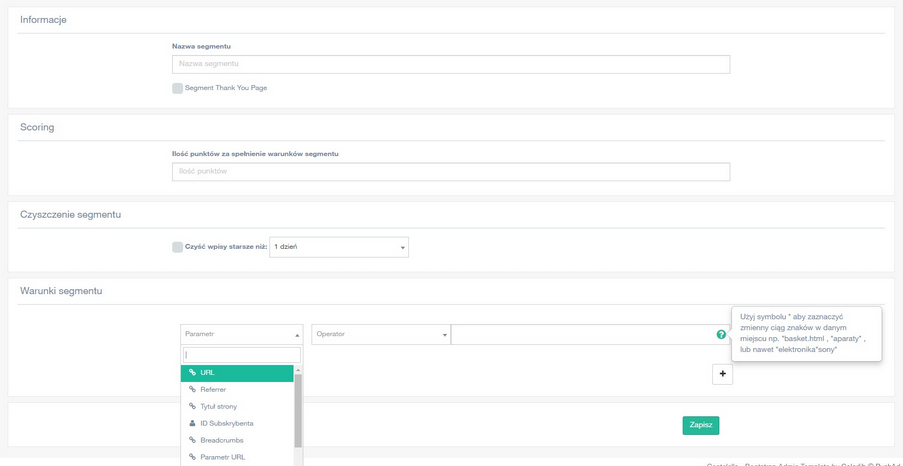
Segments created manually

Adding a sitemap to create user segmentation
Segmentation based on URL parameters
However, there are situations where segmentation relying exclusively on the use of a sitemap is not enough to group users in a satisfactory way. Such cases include websites whose operations are based on advanced filtering and sorting of data by Internet users. In such an event, a lot of valuable information about users (determined by search results) can only be obtained by extending the segmentation methods used, e.g. segmentation based on URL parameters. By imposing appropriate filters and narrowing the results to the products or services they are interested in, website users unconsciously share their preferences, purchasing intentions, or financial capacity. How is it in technical terms? Each narrowing of the search results, all kinds of filtering or sorting results in adding the imposed filtering conditions in the URL address with the use of parameters. Visually, it looks similar to UTM tagging, so individual variables are added dynamically to the end of the URL. This allows you to extract each of the user-selected conditions and create segments from them. For example, if a client was looking on a website for a 10-day trip to Greece for a 4-member family next month, filtering the results through 5-star hotels and sorting the results from the most expensive to the cheapest – we can safely assume that in the future, we can direct sales communication targeted at family, foreign and high-budget offers.
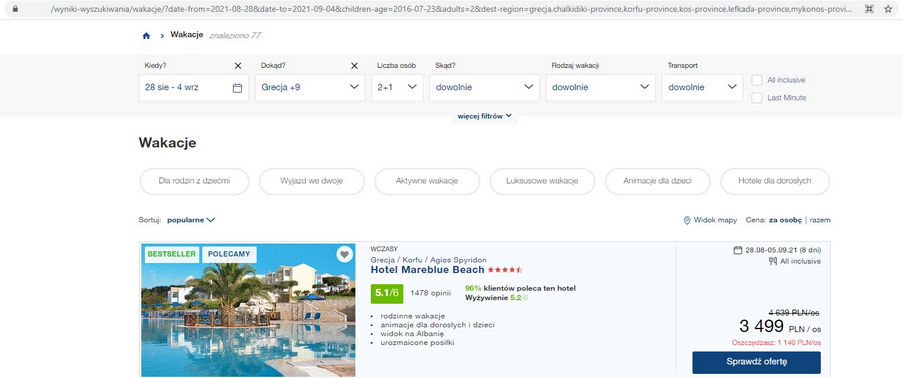
Graphics showing an extensive url generated on the basis of conditions selected by the user and segment creation from them.
Segmentation based on an external data source (CRM)
The most advanced case of segmentation is targeting using an external, properly integrated data source, e.g. CRM. This is a specific case, requiring the connection of user information between the website and the database of the CRM class system. The exchange of these pieces of data is possible, among others after the customer logs in to their account on the website. At this point, having information about the customer’s purchase history, we can fully personalise the messages displayed on the website, matching them to the user’s past (and not only) sales interactions. What does it look like in practice? At the time of logging in to the account, the system retrieves, e.g. using the digitalData object, information on the previously purchased or active products/services on this account. This is when the user falls into a pre-established segment with such conditions, and this in turn allows us to display a matching message. These can be both web push activities, but also much more advanced ones, such as customised pop-ups or dynamic content (replacing the content of individual sections on the page depending on the segment in which the user is currently located). Thus, you can build dynamically created elements of websites, promoting, for example, after-sales activities or the extension of an expiring subscription for a product or service.
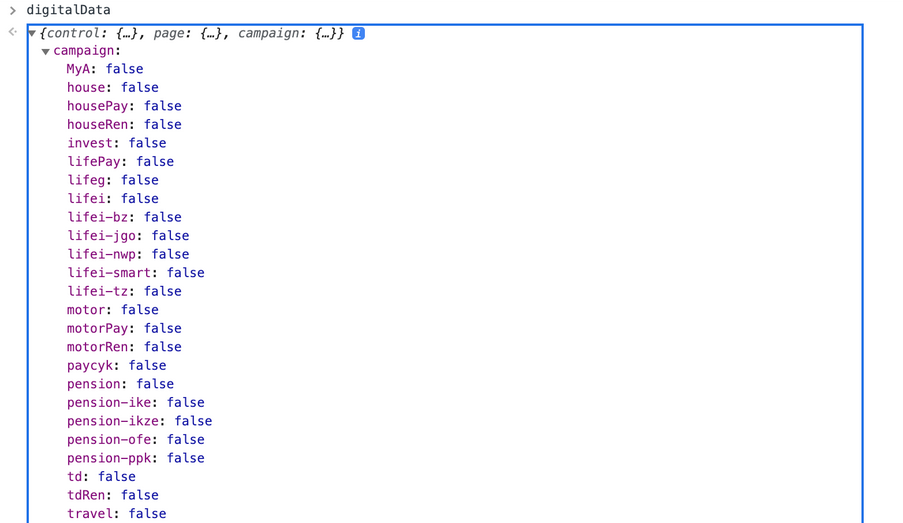
Graphics showing the digitalData view of the website

Graphics showing a listing of segments developed on the basis of digitalData
Segmentation based on breadcrumbs
An additional type of segmentation is the one based on breadcrumbs. Breadcrumbs are simply a menu path added to a standard sitemap. Subsequent parts are separated by separators and always clickable to quickly move the user to any location. Usually breadcrumbs are located at the top of the site, in a place that is easy for the user to locate. All breadcrumbs start at the home page and end at the most nested category or product, for example. Thanks to properly developed breadcrumbs navigation, we know what path the user has travelled, so we can assign the user to the right segments.
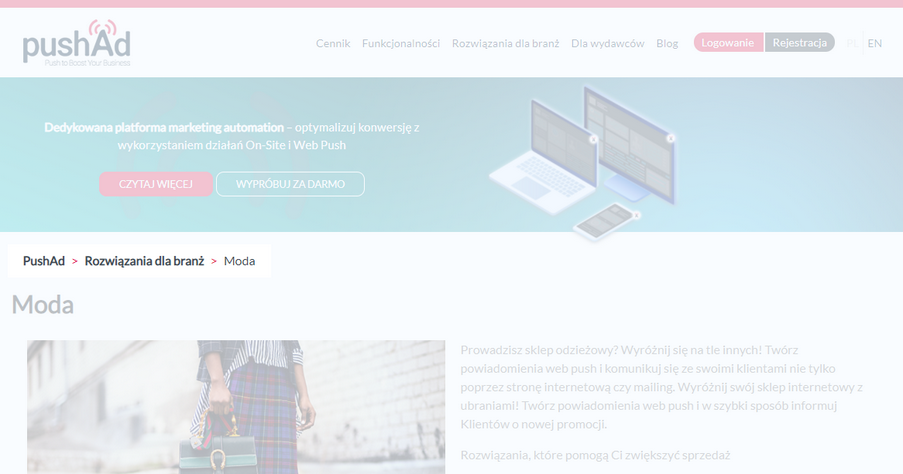
Graphics showing breadcrumbs on the PushAd website
Segmentation based on DataLayer
It is also possible to use the data contained in DataLayer for user segmentation. The DataLayer is a JavaScript object (array) that is used to pass data from a website to the Google Tag Manager container. The data that the page passes to the DataLayer can then be used to create variables, rules, and tags. DataLayer is usually provided with information after adding products to the cart or entering the booking process, usually this is the product ID, product name, price. Owing to the product ID, PushAd is able to refer to the product feed if the customer uses it and download the complete information needed about the service or product added to the cart. Sample DataLayer containing information about the hotel booked, destination, and price.

DataLayer of a travel website
When creating segments, you can use any available data, combining them into custom combinations. By sending web push campaigns to a narrower group of potential customers, we can still get better conversion than in the case of mass mailing to the entire audience base, and at the same time we do not excessively exploit the database, because we do not send messages to those who are likely not to be interested in them. In online activities, the “spray and pray” tactics, i.e. when it is impossible to define the audience of the message, is simply unprofitable. By sending a message to the entire group of users, we also risk not only the low level of CTR , but also unsubscriptions from the database due to unwanted spamming with unsuccessful marketing messages.
It is also worth paying attention to segmentation in the context of not only web push mailings, but also in terms of on-site activities, directly on the website. In PushAd, it is possible to both fully segment subscribers of web push notifications, but also – which is much more valuable – segment and monitor all website users. It allows you to reach every user of the website with an on-site message, not only subscribers of web push notifications (who constitute merely a proportion of website users). This type of targeting, using all possible formats (pop-up, website layer, survey, dynamic content), therefore allows for displaying highly personalised messages on the website, supported by data from multidimensional segmentation, and triggered by specific user actions on the website.
Thanks to the dynamic content option, we can also customise surveys and display a dedicated survey corresponding to the interests of the user in a given segment. The survey functionality includes all kinds of questions you would expect from a survey software – from simple text input and check boxes to a dynamic matrix with various types of input. Thanks to the intuitive administration panel, you can easily create extensive surveys, which you can then display to selected user segments.
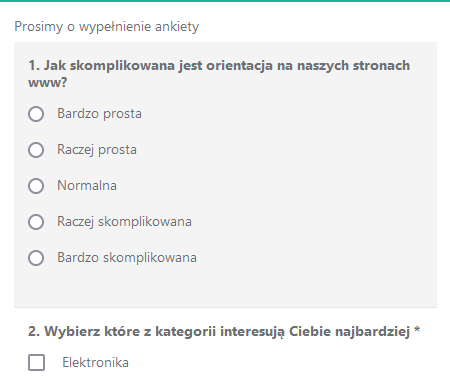
Graphics showing a sample survey embedded on the website
What other segmentation criteria can we use when designing personalised marketing campaigns with PushAd?
Demographic segmentation
When using segmentation, we rarely use a single isolated variable. Demographic segmentation is the basic form of division of the audience base, which is usually complemented by other segmentation criteria. By combining different types of segmentation, we can narrow down the target group even further. It should be borne in mind that demographic variables are strongly related to consumer preferences, needs and desires, but it is difficult to predict future demand behaviour on this basis. Demographic criteria are related to the social structure, migration and population growth – they do not refer to causal elements, but only descriptive ones.
Gender is the basic segmentation criterion – the needs of women and men are very different. This is especially true for the clothing, cosmetics, and jewellery industries. Customer expectations and needs also depend on the age group. Underage persons who still depend on their parents have different shopping habits than an adult, a person over 50 having a stable financial situation who makes independent purchasing decisions. The occupation can be related to the level of income and education. On the other hand, the consumer’s financial situation is strongly related to the frequency of making purchases. Consumers showing certain demographic characteristics also determine the demand, e.g. parents with children – for toys, and affluent people – for premium products. Based on demographic segmentation, several types of recipients can be distinguished:
- DINK (double income, no kids) – applies to people who choose to have no kids. It is assumed that they are men and women from the 25-34 age bracket, i.e. millennials (generation Y). Both partners work professionally and can afford to make free decisions on spending their money. In this target group, the greatest demand can be seen for luxury goods and the travel sector.
- YUPPY (Young, Upwardly-mobile, Prosperous, Professionals) – the abbreviation means “young urban professional” and refers to career-oriented people. The term is used to describe young people who are just starting their careers – they are characterised by an attitude to success in the industry, individualism, pragmatism, and consumerism.
- GINK (green inclinations, no kids) – the term applies to partners who do not want to have children for ecological reasons. People representing this segment believe that they have freedom of choice, and having children is associated with a greater use of natural resources.
- GLAMs (graying, leisured, affluent, middle-aged) – the abbreviation loosely translates to “graying, non-working, affluent, married” individuals and denotes wealthy people aged 45-59 years. The term describes independent consumers who are usually dedicated to their work, seldom changing position until they reach retirement age. When they retire, they want to devote their time to their interests.
The key to the success of any advertising campaign is the proper recognition and definition of the target group. Demographic segmentation relates to B2C relationships and includes common consumer characteristics, regardless of the features of the products offered. The advantage of this criterion is that the data is readily available and quite cheap to obtain. Some products target a specific demographic group. For example, a company that sells hair care products may offer two types of shampoos – for men and women, so the segmentation is based on consumer gender. Another example is the automotive industry. In this case, companies segment potential buyers by income, offering different brands and models of cars for each target group – one will choose a luxury car, while another a sports or family car.
Behavioural segmentation
Segmentation may also be perfomed based on the audience behaviour in relation to the products on the website. Behavioural profiling allows you to identify consumers’ purchasing habits on websites, which may correlate with the likelihood of making a purchase in an online store. The types of behaviour include the actions taken by users on the website, thanks to which we will be able to understand even better how potential customers use the website and what their needs are.
Behavioural segmentation in PushAd can be based on activities such as the most frequently viewed products, time spent on the website, clicks on links, reactions to ads, blog articles read or the time when the customer made a purchase. For example, the user’s greatest shopping intent is when he or she is browsing several similar products on the website – then there is a good chance of completing the order. When the user visits the website, we are able to display the products recommended for them in the form of a website layer or dynamic content embedded in the website code, which visually does not differ from the graphic design of the website.
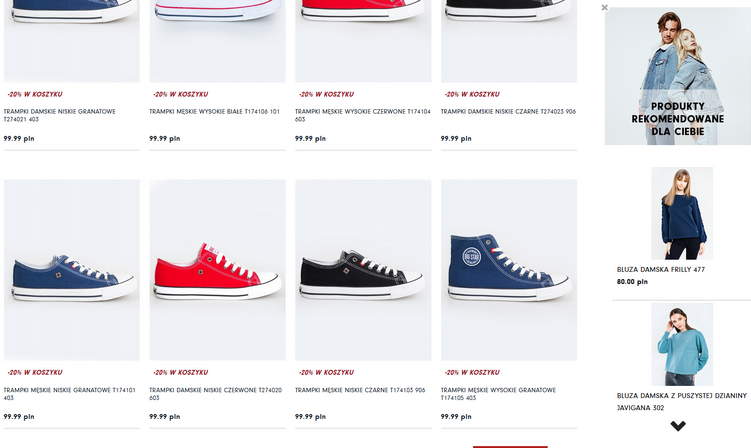
Graphics showing some recommended products displayed as a website layer
However, if the subscriber leaves the website, it is worth sending them a push notification regarding product availability and possible discount or free delivery. We should not forget that over time, a customer may change their mind or look for a similar offer from competitors. In order to adjust the way of advertising communication, it is also worth considering how customers make purchases, e.g. on a computer, tablet, or mobile device.
Thanks to PushAd, you can categorise users on the basis of their engagement – marketing activities will differ depending on whether we are dealing with a heavy user or a light user. Statistically, heavy users, or regular customers, are responsible for two-thirds of sales revenues. After some time, users may show more and more confidence in the products of the online store and the company. Then, segmentation may be based on customer loyalty – the benefits that can be offered to such a user differ from those received by a new user. Behavioural segmentation also covers purchasing patterns, incentives such as discounts, free shipping, and other perks. Behavioural data relates directly to how users interact with a particular brand or product. Knowledge on this subject will help to properly match advertising messages to customers’ preferences and needs. It should be remembered that over time, the needs, expectations, and purchasing patterns of customers may change, e.g. they will take advantage of the discount offered and then move on to the competition. So it is worth monitoring them on a regular basis.
The information obtained about consumers is just the beginning – the knowledge should be properly used to build a relationship with the customer. One of the methods of user behaviour analysis is RFM (Recency, Frequency, Monetary). The tool is used to evaluate customers based on the history of purchases. By assessing the value of the recipient, we can predict their reactions to future advertising activities and adjust the message accordingly. The RFM analysis is based on three levels – how much time has passed since the last transaction, what was the total value of the shopping cart, and how often the customer made purchases in the online store. Based on this knowledge, we can segment users and optimise spending on promotional activities of the online store.
Information on the viewed or purchased products in the online store will allow you to reach the recipient with an effective message. For example, the user was viewing a blog article on fashion trends for women and new collections of summer clothes – on the basis of such information we can assign a tag in the PushAd panel “summer dresses” so that after 24 hours the consumer receives a push notification with the latest collection of summer dresses. It is also worth creating up-selling and cross-selling campaigns – the user will add trousers worth PLN 100 to the shopping cart, and then receive a push notification encouraging them to buy more expensive trousers from organic fibers or to choose a complementary product, e.g. a belt.
Psychographic segmentation
Psychographic segmentation allows you to determine the changes in the expectations towards online store products and how the brand is perceived in the eyes of customers. This segmentation criterion relates to lifestyle, interests, activities, hobbies, aspirations or the consumer’s opinion about the brand. Thanks to marketing research, it is possible to determine the psychological profile of the user. For example, by introducing consumers to two car brands, you can get two groups with completely different personality types. The first model of the car will be chosen by self-confident, independent and impulsive people, while the other by pro-minded, reflective individuals aware of their needs. Consumers’ personality type can determine their future purchasing choices. In order for the advertisement to be even more effective and the message ideally matching the audience’s preferences, it is worth using the five-factor model of personality (Big Five).
The model describes the five main personality traits that determine consumer choices: neuroticism, extraversion, openness to experience, agreeableness, and conscientiousness. Knowing the personalities of customers is very important for achieving sales goals. Observing consumers’ reactions to the content delivered or the activities carried out will allow us to understand their desires and use them to create personalised advertising messages – the audience gets exactly what they need. For example, conscientious people may pay more attention to the technical parameters of the product than to creative advertising messages which contain general information. Knowledge on the personality profile of the audience will help to better match the offer and the manner of communication with users. Thanks to this, it is possible to properly position the brand, e.g. due to functionality, price, or a unique feature of the product.
Geographic segmentation
Geographic segmentation also helps to better understand the needs of consumers depending on their geographic location. It assumes that people living in a certain area exhibit a similar level and lifestyle. The most basic division is by country, region, voivodeship, or zip code. It is also worth identifying your audience based on the area they live in, taking into account e.g. city or village, weather conditions, or population density. Geographic segmentation is crucial if a company wants to advertise products or services in the local market. Then you should define the preferences, needs, and expectations of the audience in a given territory, bearing in mind that people in different parts of the world display different purchasing preferences, habits, or characteristics. Place marketing helps to target the message to the inhabitants of the region, meeting the needs of internal as well as external groups, such as tourists.
Geographic segmentation is also important when we want to send the message to foreigners living in Poland or Poles living abroad. In this case, you should take into account eating habits, cultural differences, and leisure activities. Depending on the industry and characteristics, companies may fail to consider segmentation or considerably narrow the criteria. One of the solutions is to undertake advertising activities in several areas, taking into account the differences in customers’ needs and preferences. In some cases, it is worth setting several levels of segmentation in the PushAd panel. First, there may be division into larger units, e.g. regions (macrosegmentation), and then separated areas according to specific criteria (microsegmentation).
Geographic criteria are clearly identifiable, but not sufficient for the sale of the products or services in question. When conducting geographic segmentation, the purchasing potential in a given region should be taken into account. The segment should be supplemented with other criteria, e.g. demographic, taking into account information on the level of income, household size, or socio-economic characteristics. The population living in rural areas in eastern Poland may show a different material status and shopping needs than the inhabitants of the capital city.
Microsegmentation and macrosegmentation
Microsegmentation is a more detailed segmentation of the audience base, which allows for grouping users in a more precise way. The starting point for segmentation can be demographic, geographic, and behavioural criteria. Microsegmentation gives you the opportunity to better understand the needs of consumers, and thus to conduct more effective marketing activities.
In the case of macrosegmentation, the reference market on which the enterprise will operate should be selected. It comes down to dividing the market into broad groups, e.g. countries. Currently, the use of macrosegmentation alone is a rare practice. For example, Coca-Cola used to offer a single range of products for the entire market, but now it focuses on more detailed segmentation (e.g. Coca-Cola Zero). Macrosegmentation is most often based on generally available demographic or geographic data. Unlike microsegmentation, it is not associated with consumer behaviour.
Effective activities within marketing automation require taking control of your data. Thanks to the PushAd platform, it is possible to create advanced scenarios that automate the process of interaction with the audience on the basis of established segments. A well-conducted segmentation helps not only to reach users who are most interested in the company’s products, but also facilitates business decisions, such as setting prices that will “maximise” sales while maintaining customer satisfaction.


